MERCEDES-BENZ GLE HYBRID 2017 Owner's Guide
Manufacturer: MERCEDES-BENZ, Model Year: 2017, Model line: GLE HYBRID, Model: MERCEDES-BENZ GLE HYBRID 2017Pages: 58, PDF Size: 1.98 MB
Page 31 of 58

Charging the high-voltage battery
Important safety notes
G DANGER
The vehicle's high-voltage electrical system is
under high voltage. If you modify components
in the vehicle's high-voltage electrical system
or touch damaged components, you may be
electrocuted. The components in the vehi-
cle's high-voltage electrical system may be
damaged in an accident, although the damage
is not visible. There is a risk of fatal injury.
Following an accident, do not touch any high-
voltage components and never modify the
vehicle's high-voltage electrical system. Have
the vehicle towed away after an accident and
the vehicle's high-voltage electrical system
checked by a qualified specialist workshop.
G WARNING
In the event of a vehicle fire, the internal pres-
sure of the high-voltage battery can exceed a
critical value. In this case flammable gas
escapes through a ventilation valve on the
underbody. The gas can ignite. There is a risk
of injury.
Leave the danger zone immediately. Secure
the danger area at a suitable distance, whilst
observing legal requirements.
G DANGER
Connecting the charging cable to the mains
supply via incorrectly installed mains sockets
or by means of adapters, extension cables or
similar could cause a fire or an electric shock.
There is a risk of fatal injury.
To avoid hazardous situations, observe the
following: R
Only connect the charging cable to mains
sockets: -
which have been properly installed and -
which have been inspected by a qualified
electrician R
For safety reasons, only use the charging
cables supplied with the vehicle, or charg- ing cables which have been approved for
use with this vehicle. R
Never use a damaged charging cable. R
Do not use: -
extension cables -
extension reels -
multiple sockets R
Never use socket adapters to connect the
charging cable to the mains socket. The
only exception being if the adapter has
been tested and approved by the manufac-
turer for charging the high-voltage battery
of an electric vehicle. R
Observe the safety notes in the operating
instructions for the socket adapter.
G DANGER
Connecting the charging cable to the vehicle
via an incorrectly installed wallbox or by
means of adapters, extension cables or simi-
lar could cause a fire or an electric shock.
There is a risk of fatal injury.
To avoid hazardous situations, observe the
following: R
Only connect the charging cable to a wall-
box if: -
the wallbox is properly installed -
the wallbox has been inspected by a
qualified electrician -
the charging cable is not damaged. R
Do not extend the charging cable. R
Do not use an adapter. R
Always observe the safety notes in the wall-
box's operating instructions.
The vehicle's high voltage electrical system is
under high voltage. R
Do not tamper with the high-voltage compo-
nents or the orange cables of the high-voltage
electrical system. R
Do not touch high-voltage components or the
orange cables of the high-voltage electrical
system when a vehicle has been involved in a
crash.Charging the high-voltage battery 29
Driving and parking Z
Page 32 of 58
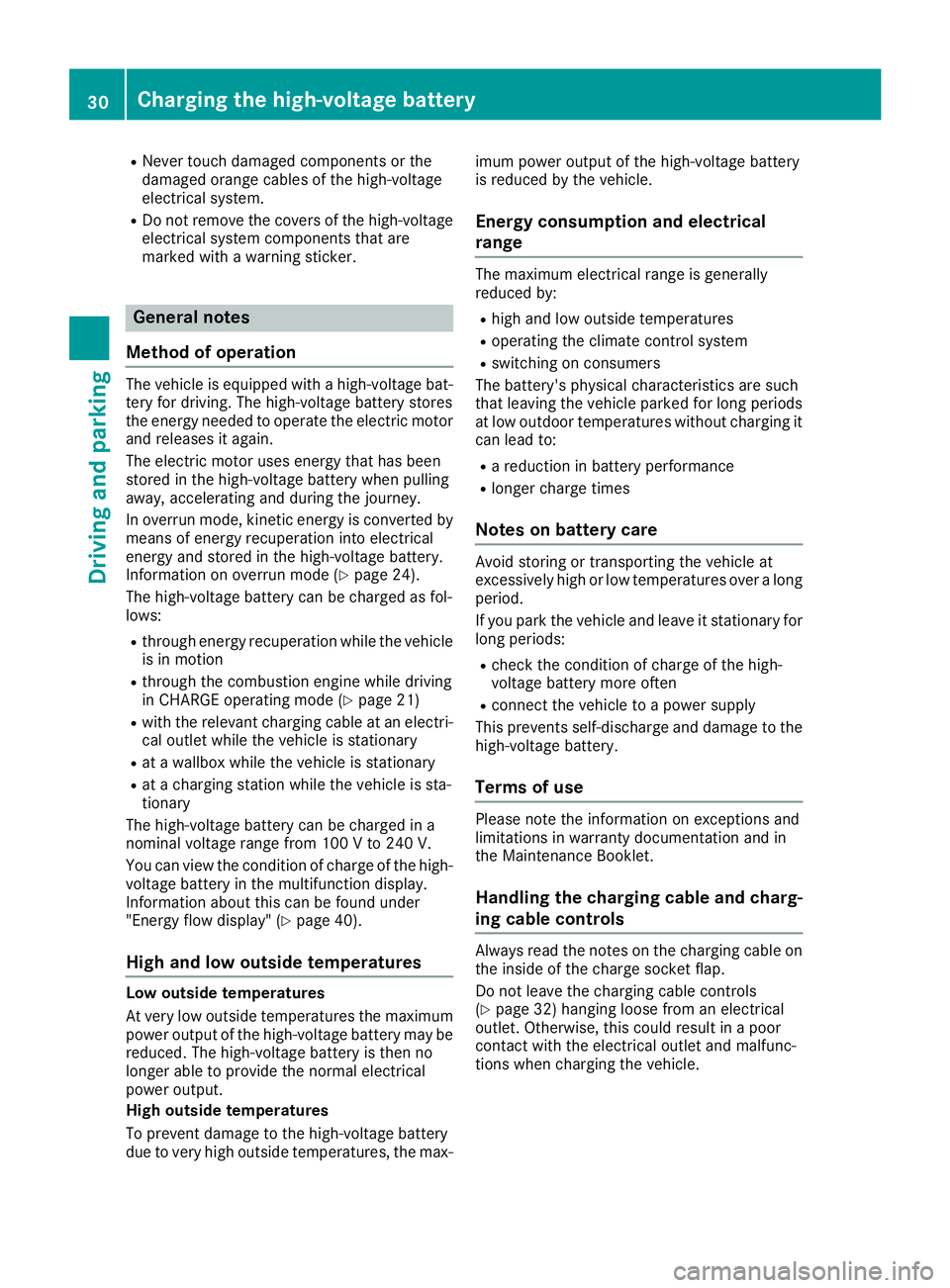
R
Never touch damaged components or the
damaged orange cables of the high-voltage
electrical system. R
Do not remove the covers of the high-voltage
electrical system components that are
marked with a warning sticker.
General notes
Method of operation The vehicle is equipped with a high-voltage bat-
tery for driving. The high-voltage battery stores
the energy needed to operate the electric motor
and releases it again.
The electric motor uses energy that has been
stored in the high-voltage battery when pulling
away, accelerating and during the journey.
In overrun mode, kinetic energy is converted by
means of energy recuperation into electrical
energy and stored in the high-voltage battery.
Information on overrun mode ( Y
page 24).
The high-voltage battery can be charged as fol-
lows: R
through energy recuperation while the vehicle
is in motion R
through the combustion engine while driving
in CHARGE operating mode ( Y
page 21)R
with the relevant charging cable at an electri-
cal outlet while the vehicle is stationary R
at a wallbox while the vehicle is stationary R
at a charging station while the vehicle is sta-
tionary
The high-voltage battery can be charged in a
nominal voltage range from 100 V to 240 V.
You can view the condition of charge of the high-
voltage battery in the multifunction display.
Information about this can be found under
"Energy flow display" ( Y
page 40).
High and low outside temperatures Low outside temperatures
At very low outside temperatures the maximum
power output of the high-voltage battery may be
reduced. The high-voltage battery is then no
longer able to provide the normal electrical
power output.
High outside temperatures
To prevent damage to the high-voltage battery
due to very high outside temperatures, the max- imum power output of the high-voltage battery
is reduced by the vehicle.
Energy consumption and electrical
range The maximum electrical range is generally
reduced by: R
high and low outside temperatures R
operating the climate control system R
switching on consumers
The battery's physical characteristics are such
that leaving the vehicle parked for long periods
at low outdoor temperatures without charging it
can lead to: R
a reduction in battery performance R
longer charge times
Notes on battery care Avoid storing or transporting the vehicle at
excessively high or low temperatures over a long
period.
If you park the vehicle and leave it stationary for
long periods: R
check the condition of charge of the high-
voltage battery more often R
connect the vehicle to a power supply
This prevents self-discharge and damage to the
high-voltage battery.
Terms of use Please note the information on exceptions and
limitations in warranty documentation and in
the Maintenance Booklet.
Handling the charging cable and charg-
ing cable controls Always read the notes on the charging cable on
the inside of the charge socket flap.
Do not leave the charging cable controls
( Y
page 32) hanging loose from an electrical
outlet. Otherwise, this could result in a poor
contact with the electrical outlet and malfunc-
tions when charging the vehicle.30
Charging the high-voltage battery
Driving and parking
Page 33 of 58
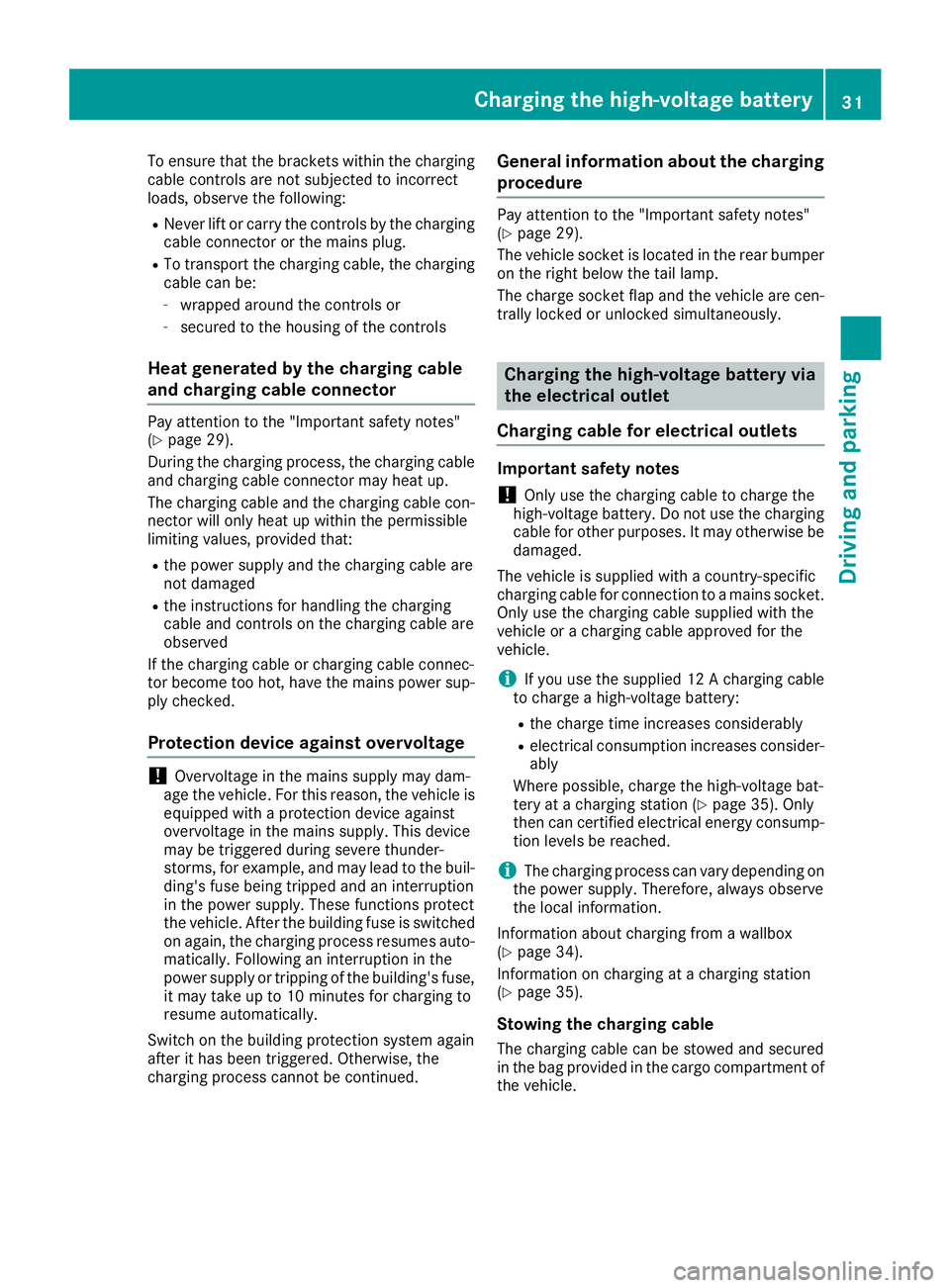
To ensure that the brackets within the charging
cable controls are not subjected to incorrect
loads, observe the following: R
Never lift or carry the controls by the charging
cable connector or the mains plug. R
To transport the charging cable, the charging
cable can be: -
wrapped around the controls or -
secured to the housing of the controls
Heat generated by the charging cable
and charging cable connector Pay attention to the "Important safety notes"
( Y
page 29).
During the charging process, the charging cable
and charging cable connector may heat up.
The charging cable and the charging cable con-
nector will only heat up within the permissible
limiting values, provided that: R
the power supply and the charging cable are
not damaged R
the instructions for handling the charging
cable and controls on the charging cable are
observed
If the charging cable or charging cable connec-
tor become too hot, have the mains power sup-
ply checked.
Protection device against overvoltage
! Overvoltage in the mains supply may dam-
age the vehicle. For this reason, the vehicle is
equipped with a protection device against
overvoltage in the mains supply. This device
may be triggered during severe thunder-
storms, for example, and may lead to the buil-
ding's fuse being tripped and an interruption
in the power supply. These functions protect
the vehicle. After the building fuse is switched
on again, the charging process resumes auto-
matically. Following an interruption in the
power supply or tripping of the building's fuse,
it may take up to 10 minutes for charging to
resume automatically.
Switch on the building protection system again
after it has been triggered. Otherwise, the
charging process cannot be continued. General information about the charging
procedure Pay attention to the "Important safety notes"
( Y
page 29).
The vehicle socket is located in the rear bumper
on the right below the tail lamp.
The charge socket flap and the vehicle are cen-
trally locked or unlocked simultaneously.
Charging the high-voltage battery via
the electrical outlet
Charging cable for electrical outlets Important safety notes
! Only use the charging cable to charge the
high-voltage battery. Do not use the charging
cable for other purposes. It may otherwise be
damaged.
The vehicle is supplied with a country-specific
charging cable for connection to a mains socket.
Only use the charging cable supplied with the
vehicle or a charging cable approved for the
vehicle.
i If you use the supplied 12 A charging cable
to charge a high-voltage battery: R
the charge time increases considerably R
electrical consumption increases consider-
ably
Where possible, charge the high-voltage bat-
tery at a charging station ( Y
page 35). Only
then can certified electrical energy consump-
tion levels be reached.
i The charging process can vary depending on
the power supply. Therefore, always observe
the local information.
Information about charging from a wallbox
( Y
page 34).
Information on charging at a charging station
( Y
page 35).
Stowing the charging cable
The charging cable can be stowed and secured
in the bag provided in the cargo compartment of
the vehicle.Charging the high-voltage battery 31
Driving and parking Z
Page 34 of 58
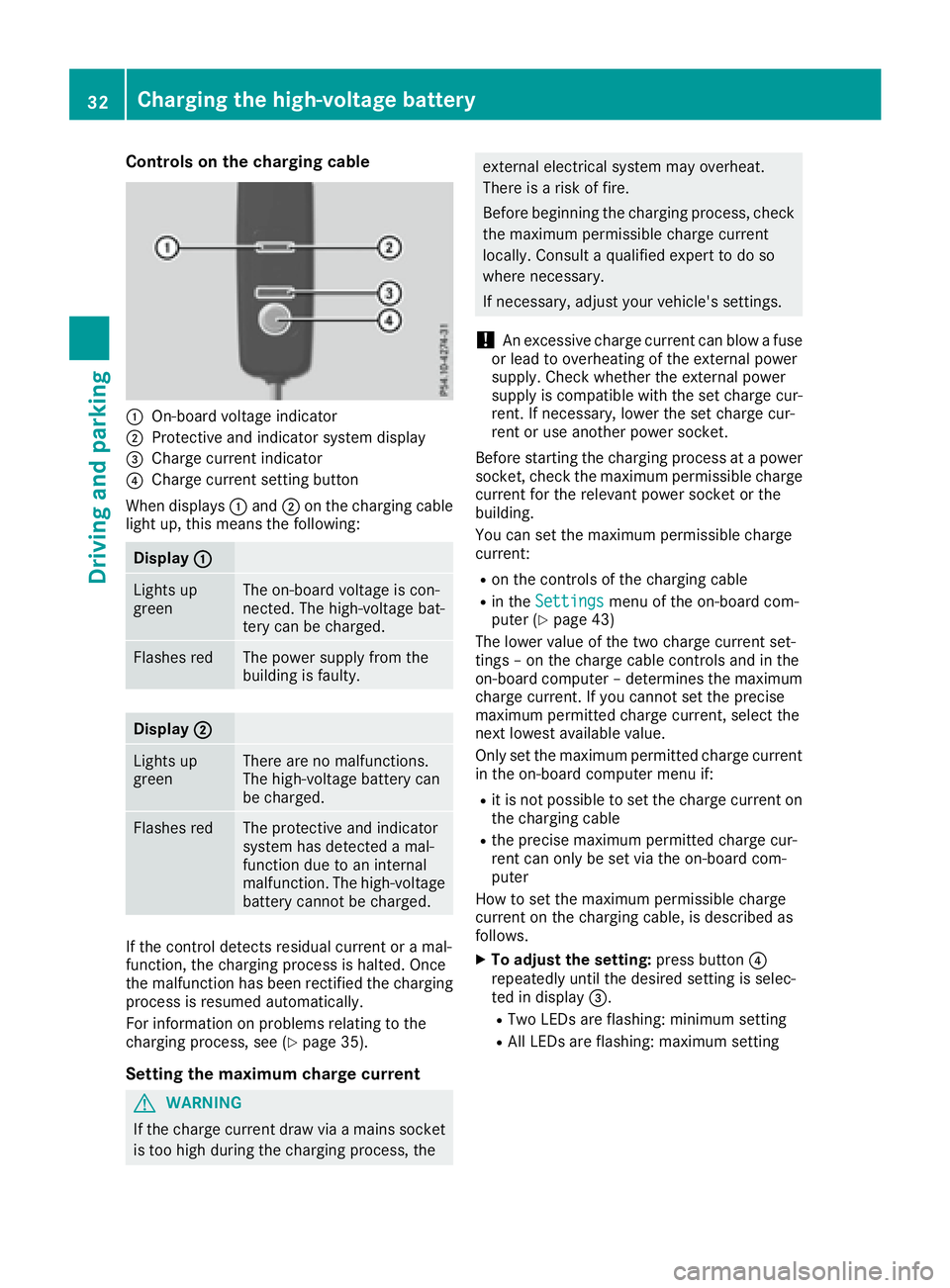
Controls on the charging cable
�C
On-board voltage indicator�D
Protective and indicator system display�
Page 35 of 58
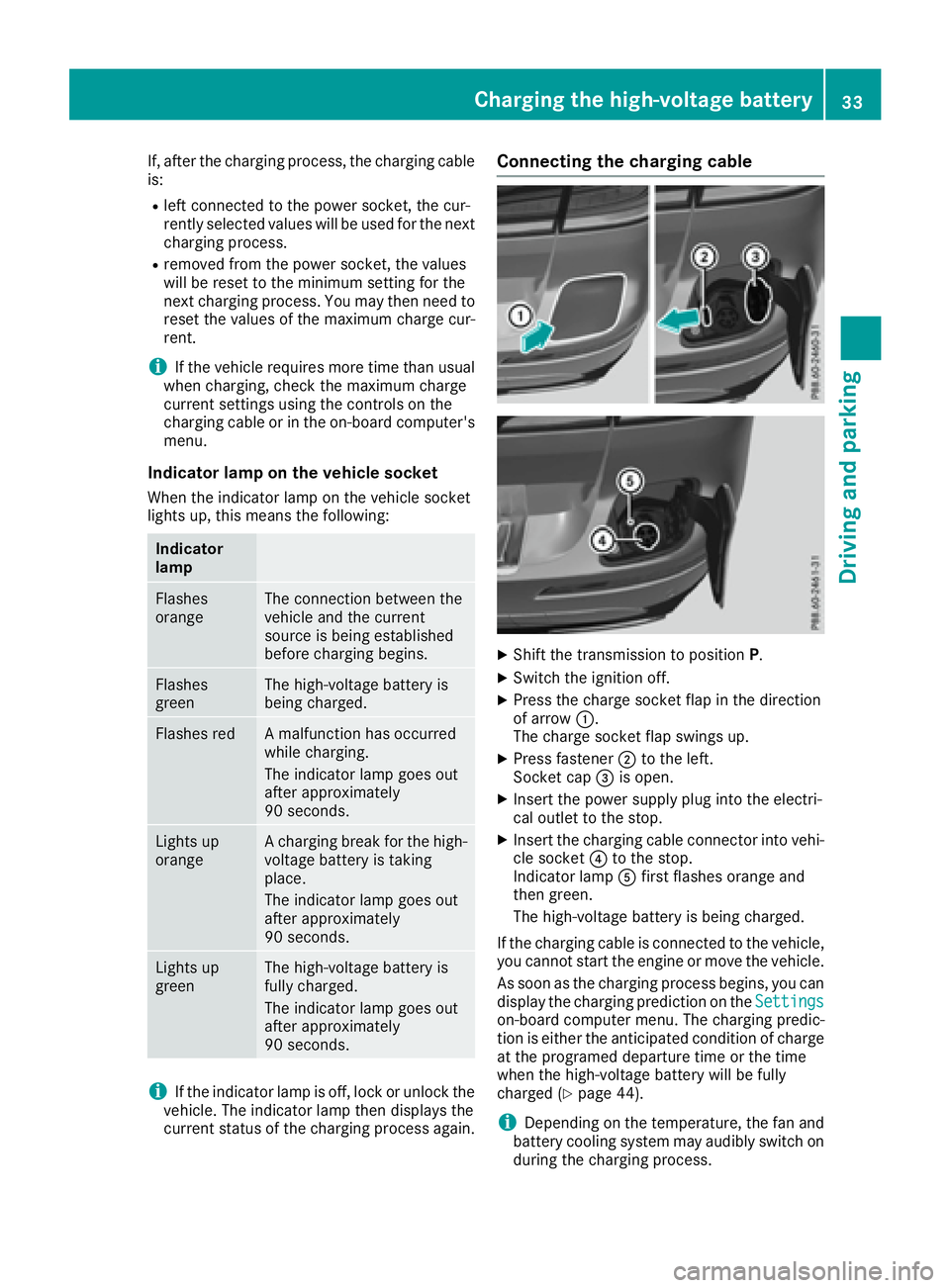
If, after the charging process, the charging cable
is: R
left connected to the power socket, the cur-
rently selected values will be used for the next
charging process. R
removed from the power socket, the values
will be reset to the minimum setting for the
next charging process. You may then need to
reset the values of the maximum charge cur-
rent.
i If the vehicle requires more time than usual
when charging, check the maximum charge
current settings using the controls on the
charging cable or in the on-board computer's
menu.
Indicator lamp on the vehicle socket When the indicator lamp on the vehicle socket
lights up, this means the following:
Indicator
lamp
Flashes
orange The connection between the
vehicle and the current
source is being established
before charging begins.
Flashes
green The high-voltage battery is
being charged.
Flashes red A malfunction has occurred
while charging.
The indicator lamp goes out
after approximately
90 seconds.
Lights up
orange A charging break for the high-
voltage battery is taking
place.
The indicator lamp goes out
after approximately
90 seconds.
Lights up
green The high-voltage battery is
fully charged.
The indicator lamp goes out
after approximately
90 seconds.
i If the indicator lamp is off, lock or unlock the
vehicle. The indicator lamp then displays the
current status of the charging process again. Connecting the charging cable
X
Shift the transmission to position P .X
Switch the ignition off. X
Press the charge socket flap in the direction
of arrow �C .
The charge socket flap swings up. X
Press fastener �D to the left.
Socket cap �
Page 36 of 58
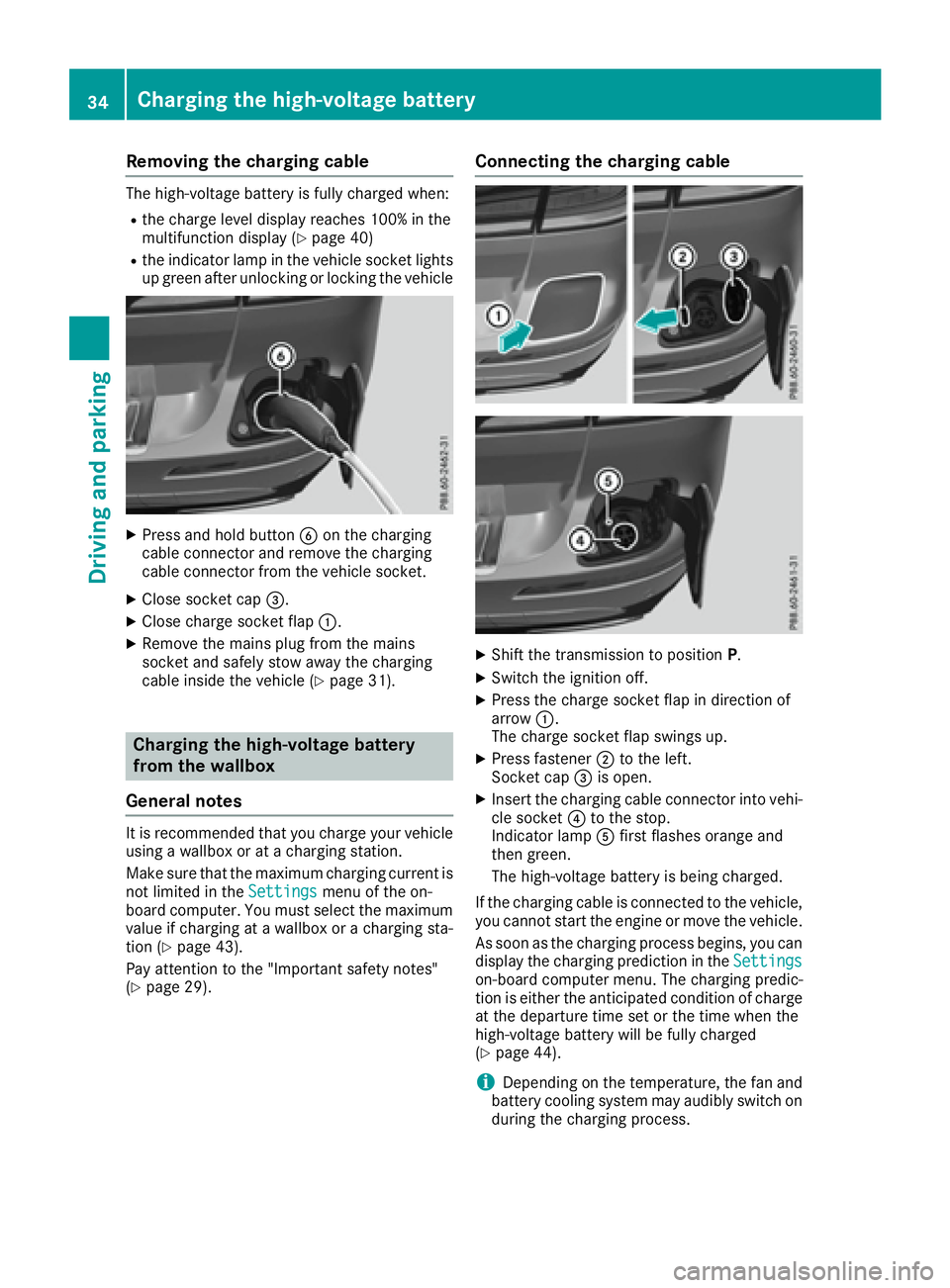
Removing the charging cable The high-voltage battery is fully charged when: R
the charge level display reaches 100% in the
multifunction display ( Y
page 40)R
the indicator lamp in the vehicle socket lights
up green after unlocking or locking the vehicle
X
Press and hold button �
Page 37 of 58
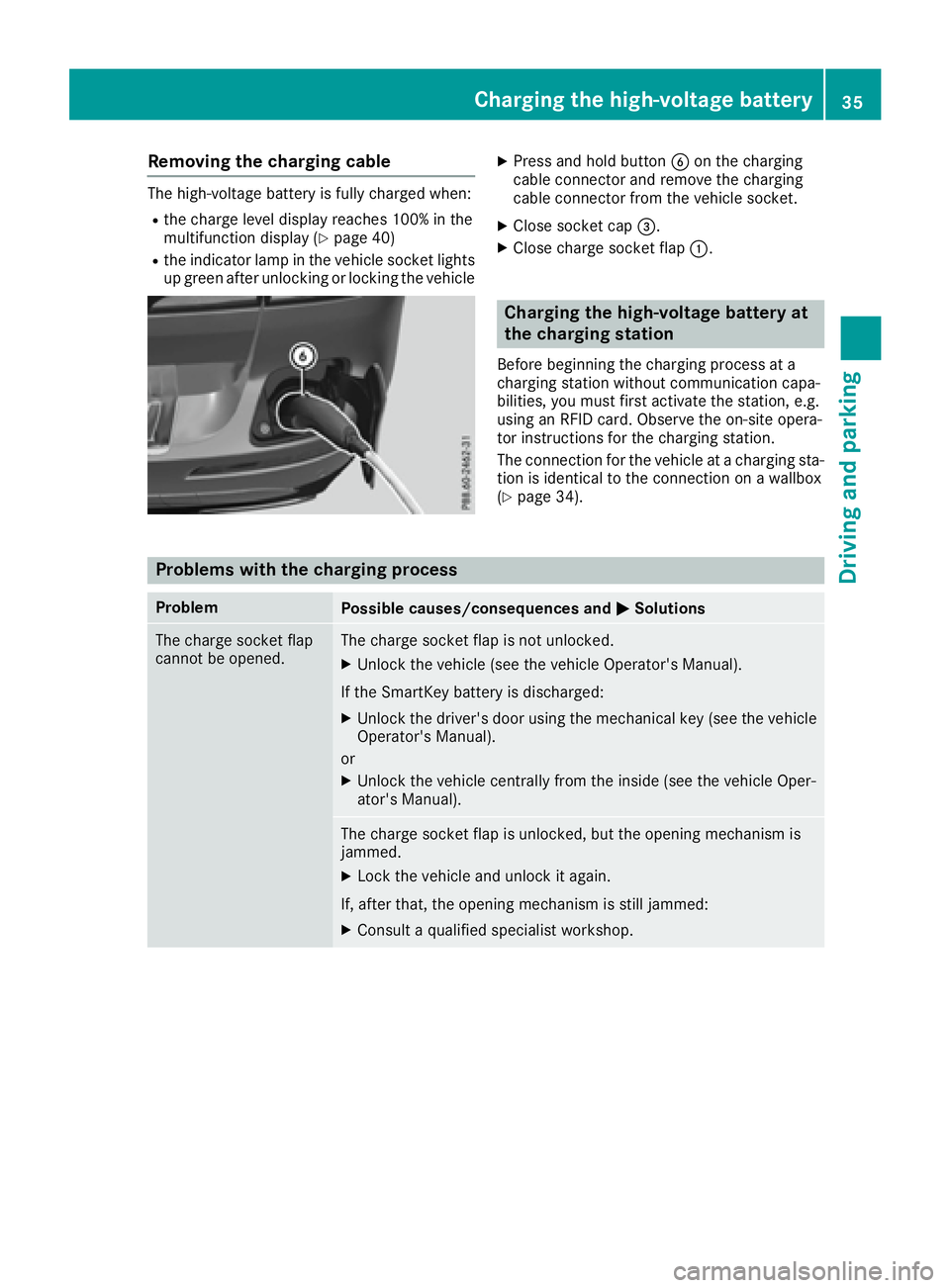
Removing the charging cable The high-voltage battery is fully charged when: R
the charge level display reaches 100% in the
multifunction display ( Y
page 40)R
the indicator lamp in the vehicle socket lights
up green after unlocking or locking the vehicle X
Press and hold button �
Page 38 of 58
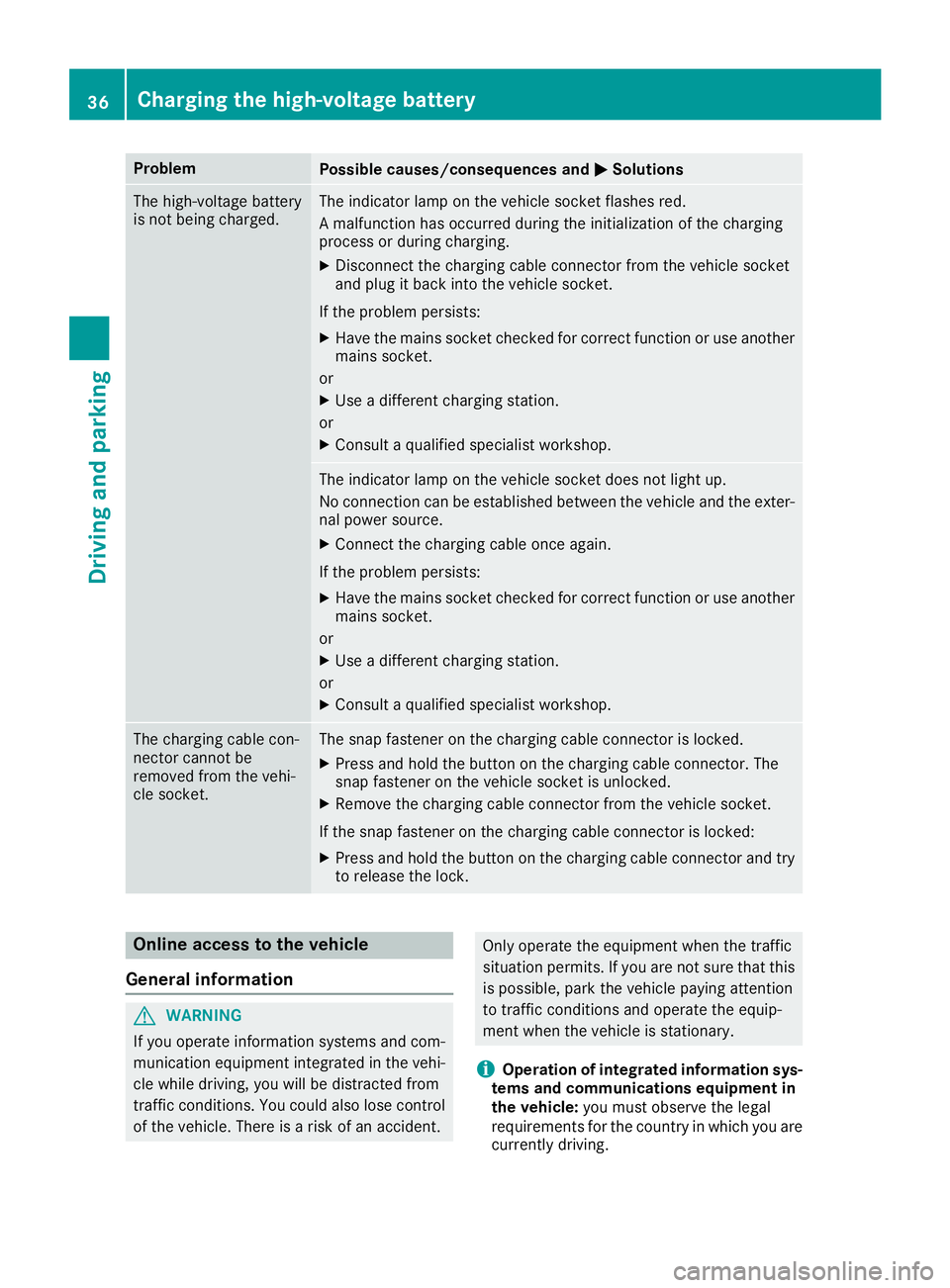
Problem
Possible causes/consequences and �P Solutions
The high-voltage battery
is not being charged. The indicator lamp on the vehicle socket flashes red.
A malfunction has occurred during the initialization of the charging
process or during charging. X
Disconnect the charging cable connector from the vehicle socket
and plug it back into the vehicle socket.
If the problem persists: X
Have the mains socket checked for correct function or use another
mains socket.
or X
Use a different charging station.
or X
Consult a qualified specialist workshop.
The indicator lamp on the vehicle socket does not light up.
No connection can be established between the vehicle and the exter-
nal power source. X
Connect the charging cable once again.
If the problem persists: X
Have the mains socket checked for correct function or use another
mains socket.
or X
Use a different charging station.
or X
Consult a qualified specialist workshop.
The charging cable con-
nector cannot be
removed from the vehi-
cle socket. The snap fastener on the charging cable connector is locked. X
Press and hold the button on the charging cable connector. The
snap fastener on the vehicle socket is unlocked. X
Remove the charging cable connector from the vehicle socket.
If the snap fastener on the charging cable connector is locked: X
Press and hold the button on the charging cable connector and try
to release the lock.
Online access to the vehicle
General information
G WARNING
If you operate information systems and com-
munication equipment integrated in the vehi-
cle while driving, you will be distracted from
traffic conditions. You could also lose control
of the vehicle. There is a risk of an accident. Only operate the equipment when the traffic
situation permits. If you are not sure that this
is possible, park the vehicle paying attention
to traffic conditions and operate the equip-
ment when the vehicle is stationary.
i Operation of integrated information sys-
tems and communications equipment in
the vehicle: you must observe the legal
requirements for the country in which you are
currently driving.36
Charging the high-voltage battery
Driving and parking
Page 39 of 58
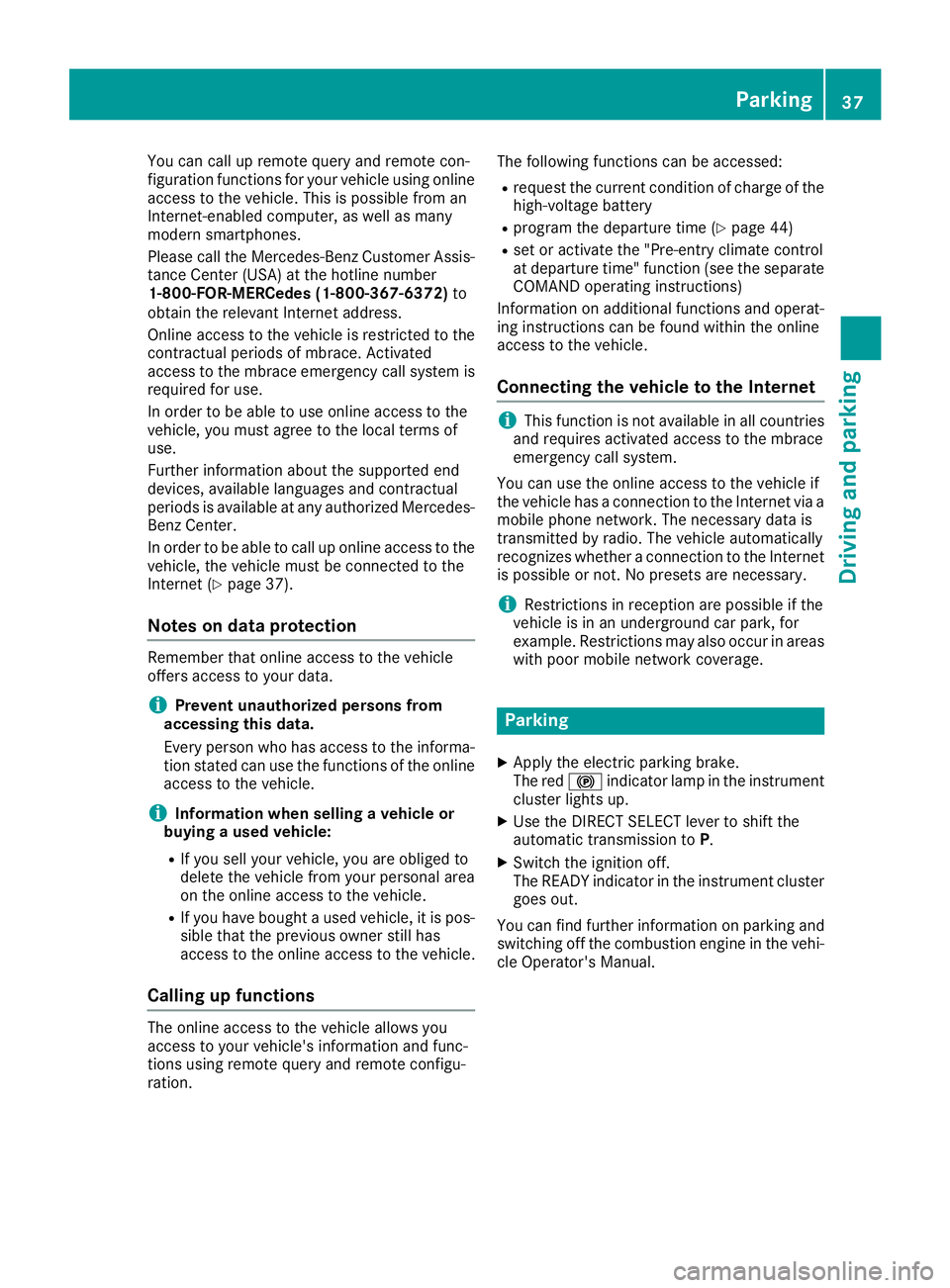
You can call up remote query and remote con-
figuration functions for your vehicle using online
access to the vehicle. This is possible from an
Internet-enabled computer, as well as many
modern smartphones.
Please call the Mercedes-Benz Customer Assis-
tance Center (USA) at the hotline number
1-800-FOR-MERCedes (1-800-367-6372) to
obtain the relevant Internet address.
Online access to the vehicle is restricted to the
contractual periods of mbrace. Activated
access to the mbrace emergency call system is
required for use.
In order to be able to use online access to the
vehicle, you must agree to the local terms of
use.
Further information about the supported end
devices, available languages and contractual
periods is available at any authorized Mercedes-
Benz Center.
In order to be able to call up online access to the
vehicle, the vehicle must be connected to the
Internet ( Y
page 37).
Notes on data protection Remember that online access to the vehicle
offers access to your data.
i Prevent unauthorized persons from
accessing this data.
Every person who has access to the informa-
tion stated can use the functions of the online
access to the vehicle.
i Information when selling a vehicle or
buying a used vehicle: R
If you sell your vehicle, you are obliged to
delete the vehicle from your personal area
on the online access to the vehicle. R
If you have bought a used vehicle, it is pos-
sible that the previous owner still has
access to the online access to the vehicle.
Calling up functions
The online access to the vehicle allows you
access to your vehicle's information and func-
tions using remote query and remote configu-
ration. The following functions can be accessed: R
request the current condition of charge of the
high-voltage battery R
program the departure time ( Y
page 44)R
set or activate the "Pre-entry climate control
at departure time" function (see the separate
COMAND operating instructions)
Information on additional functions and operat-
ing instructions can be found within the online
access to the vehicle.
Connecting the vehicle to the Internet
i This function is not available in all countries
and requires activated access to the mbrace
emergency call system.
You can use the online access to the vehicle if
the vehicle has a connection to the Internet via a
mobile phone network. The necessary data is
transmitted by radio. The vehicle automatically
recognizes whether a connection to the Internet
is possible or not. No presets are necessary.
i Restrictions in reception are possible if the
vehicle is in an underground car park, for
example. Restrictions may also occur in areas
with poor mobile network coverage.
Parking X
Apply the electric parking brake.
The red �$ indicator lamp in the instrument
cluster lights up. X
Use the DIRECT SELECT lever to shift the
automatic transmission to P .X
Switch the ignition off.
The READY indicator in the instrument cluster
goes out.
You can find further information on parking and
switching off the combustion engine in the vehi-
cle Operator's Manual. Parking 37
Driving and parking Z
Page 40 of 58
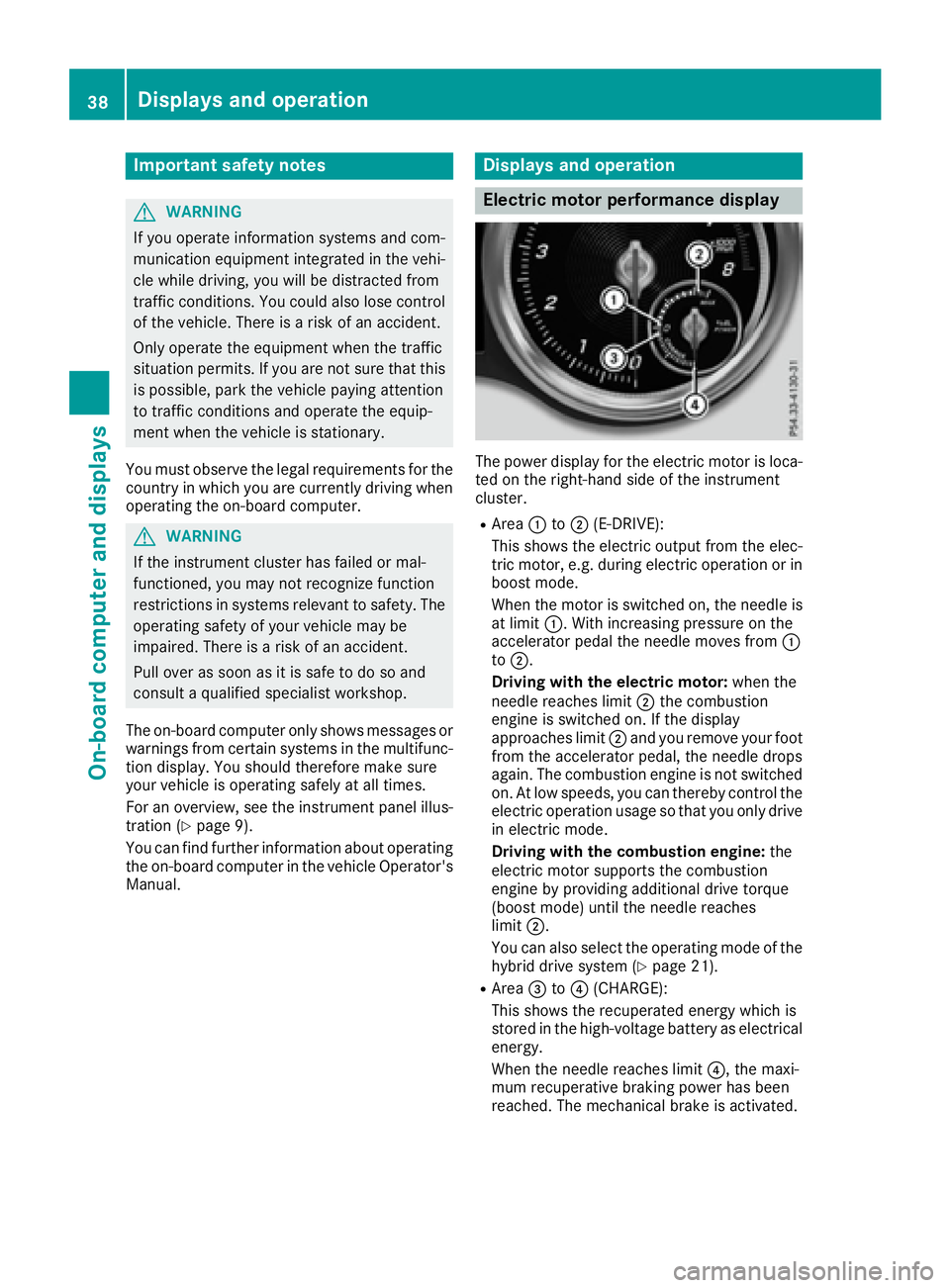
Important safety notes
G WARNIN G
If you operate information systems and com-
munication equipmen t integrate d in th e vehi-
cle while driving , you will be distracte d from
traffic conditions. You could also lose control
of th e vehicle. Ther e is a ris k of an accident.
Only operate th e equipmen t when th e traffic
situation permits. If you are no t sur e that this
is possible , park th e vehicl e payin g attention
to traffic condition s and operate th e equip-
men t when th e vehicl e is stationary.
You must observ e th e legal requirements for th e
country in whic h you are currentl y driving when
operating th e on-board computer.
G WARNIN G
If th e instrumen t cluste r has faile d or mal-
functioned, you may no t recognize function
restriction s in systems relevan t to safety. The
operating safet y of your vehicl e may be
impaired . Ther e is a ris k of an accident.
Pull ove r as soo n as it is saf e to do so and
consult a qualified specialist workshop.
The on-board computer only shows message s or
warning s from certain systems in th e multifunc-
tion display. You should therefor e mak e sur e
your vehicl e is operating safely at all times .
Fo r an overview, see th e instrumen t panel illus-
tration ( Y
page 9).
You can fin d further information about operating
th e on-board computer in th e vehicl e Operator's
Manual. Displays and operation
Electric motor performance display
The power display for th e electric motor is loca-
te d on th e right-hand side of th e instrumen t
cluster. R
Area �C to �D (E-DRIVE):
This shows th e electric output from th e elec -
tric motor, e.g. during electric operation or in
boos t mode.
When th e motor is switched on , th e needle is
at limi t �C . Wit h increasing pressur e on th e
accelerato r pedal th e needle moves from �C
to �D .
Driving with th e electri c motor: when th e
needle reaches limi t �D th e combustion
engin e is switched on . If th e display
approaches limi t �D and you remove your foo t
from th e accelerato r pedal , th e needle drops
again . The combustion engin e is no t switched
on . At low speeds, you can thereby control th e
electric operation usage so that you only driv e
in electric mode.
Driving with th e combustion engine: th e
electric motor support s th e combustion
engin e by providing additional driv e torque
(boost mode) until th e needle reaches
limi t �D .
You can also select th e operating mod e of th e
hybrid driv e system ( Y
page 21) .R
Area �